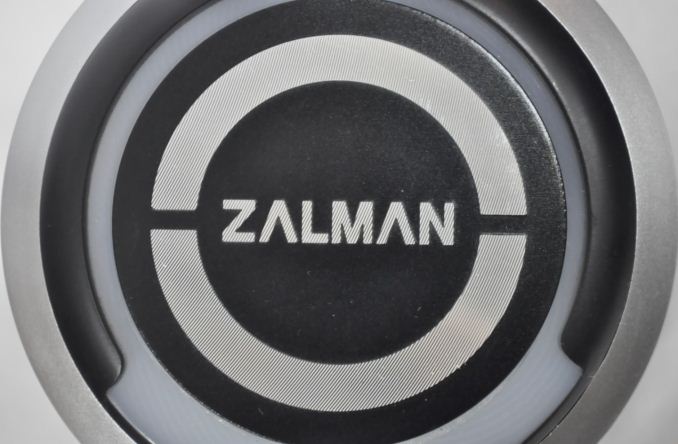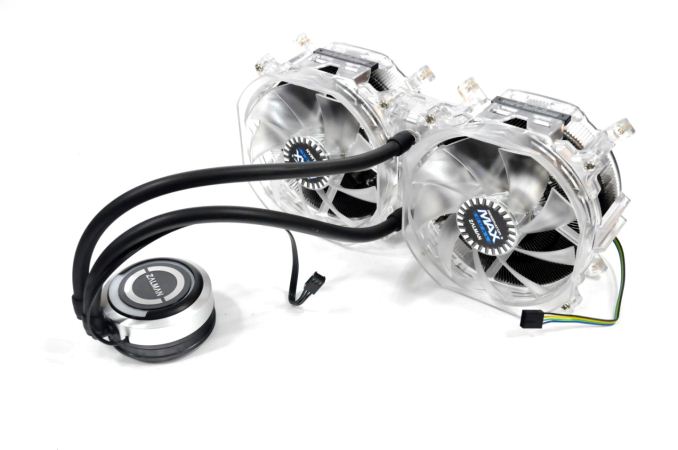Zalman Reserator 3 Max Dual CPU Cooler Review
by E. Fylladitakis on August 19, 2014 6:00 PM EST
Introduction
A few months ago, we had a look at many all-in-one liquid cooling solutions, ranging from low cost solutions to enthusiast-grade products. However, regardless of their size and capabilities, all of those kits were quite similar to each other. Today we have something that truly stands out from the crowd, Zalman's latest liquid-cooling solution, the Reserator 3 Max Dual.
Zalman's engineers are no amateurs when it comes to liquid cooling; they actually are one of the first companies that shipped liquid cooling solutions as complete retail products, so they have extensive experience in that particular field. The Reserator 3 Max Dual is being advertised as the "Ultimate Liquid CPU Cooler" and it currently retails for $140 including shipping, making it one of the most expensive all-in-one solutions available. It's clearly aimed at overclockers and enthusiasts, but is Zalman's newest creation worthy of such a heavy title and premium price? We will find out in this review.
Packaging and bundle
We received the Reserator 3 Max Dual in a large, dark cardboard box with little aesthetic appeal, as the artwork is based on a picture of the radiator. Blister plastic packaging protects the cooler inside the box. The bundled items are supplied into two plastic bags, entirely unorganized. Besides the hardware required for the mounting of the cooler and the instruction manuals, Zalman does not provide anything else. The thermal paste is the weak link of the bundle, as only a single dose of average thermal paste is supplied, when most users would expect at least a small syringe with high-quality thermal paste with such a premium product.













52 Comments
View All Comments
C'DaleRider - Tuesday, August 19, 2014 - link
Looks like it's suffered the fate most radiators that used round tubes had....poor performance, and probably due to laminar flow issues. Read on another forum about testing done by some of the "pioneers" in watercooling and issues faced by round tube radiators. Lack of surface area being actively cooled and laminar flow problems.Ever wonder why the "real" water cooling crowd has almost no round tube radiators to choose from?
liu_d - Tuesday, August 19, 2014 - link
The reason most rads don't use round tubing is cost. If you look at the few radiators on the market that do (Aquacomputer Airplex, Feser Admiral), they are considerably more expensive than corrugated-fin radiators of similar size. This is because instead of just folding the fins back and forth between flat water tubes, round tubes need a soldered fin stack (like most heatpipe air coolers) which is more complicated to manufacture.owan - Wednesday, August 20, 2014 - link
Well, you're right that those radiators are expensive, likely due to the construction complexity, but they really don't perform anywhere close to accordingly for their cost. I've seen results showing that the Aquacomputer rads perform measurably worse than typical rads at half the price, likely for the reasons C'DaleRider mentioned.garadante - Tuesday, August 19, 2014 - link
I would really like to see a roundup of the radiators when they're all using the same fan. I was really impressed by the Cooler Master Nepton 280L... Until I noticed fan speed and noise levels. The H110 seems like the best CLC in this roundup by far for having #2/#3 performance at significantly lower fan speeds and noise levels. I know there's the argument for testing CLCs exactly as they come in the packaging, but if you're spending $100+ on a radiator already for a 5-10 C temperature decrease, another $20-30 for a further 5 degree C decrease or even greater isn't a stretch. And if you do such a roundup, having a standard push vs push-pull setup would be great too, to see what the benefits are and which radiators benefit most from the increase static pressure.garadante - Tuesday, August 19, 2014 - link
And it would be worth looking into if the Corsair H105/similar thick radiators perform better with certain fan setups. Because as it is, the performance is severely lacking in all of the reviews I've seen for the H105 and other thick radiators compared to a 280mm radiator. It would be interesting to find out if the extra radiator thickness comes in handy with enough static pressure or airflow or some combination thereof, or if it's just better to go for more surface area in all use cases. It's much easier to find a case compatible with a 280mm radiator than an extra thick radiator, especially if you want to use push-pull fans.HanzNFranzen - Thursday, August 21, 2014 - link
I see where you are coming from, but the problem with testing all rads with the same fan is that each radiator performs differently depending on the type of fan used. You could have radiator X that performs better than radiator Y with a Noctua fan and then see the results change in favor of radiator Y when using Corsair fans (just using brands as an example). Combinations of different fan pressures and different radiator thickness and fin densities are all going to skew the results from one fan to another.skrewler2 - Saturday, August 23, 2014 - link
you are correct, but that's the entire point. also, no one said anything about using only 1 fan. would be nice to see the results with it stock and some of the most popular / performant fans. Then run the tests with the same fans against all the other units.kwrzesien - Wednesday, August 20, 2014 - link
I'm not sure why he lowered the pump voltage to 7V along with the fans (which seems to be how the article describes it), as far as I can tell most systems leave the pump at a full 12V without any noise issues. Who knows what impact this has on the performance of each of these CLC's but I think it has 0% chance of being used this way in the real world.E.Fyll - Wednesday, August 20, 2014 - link
The pump voltage is controlled by your motherboard and will be reduced if the thermal control is not disabled in the BIOS, much like it would do with a typical fan. Therefore, I am taking the path that the majority of users would take, which is to leave the BIOS at default settings and allow the thermal control to do its thing.Besides, "most" is not "all". For example, the Coolermaster V series is using a pump that is rather noisy. It would not be fair to test some coolers with the pump at maximum speed and some with the pump at a reduced speed, as this obviously has a sizable impact on performance. Everything is being tested under the exact same conditions, otherwise the very use of the word "testing" would be an insult to my ears.
E.Fyll - Wednesday, August 20, 2014 - link
Actually, that would be misleading. The performance of the coolers would then rely on the P/V curve of the specific fan used for the test. Each radiator is causing a specific, unique pressure drop and each fan will behave different at each static pressure level. Therefore, the use of a specific fan would favor some designs and cripple others. Switching that fan to another model would yield different results as well. I cannot possibly test every fan out there. I can only be testing each product as a stand-alone solution, it is not possible to account for every possible modification that users may or may not perform.